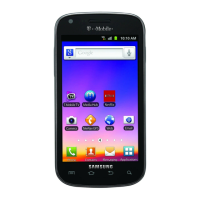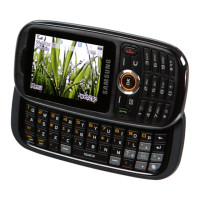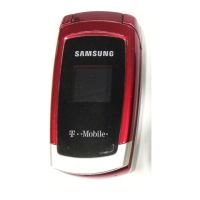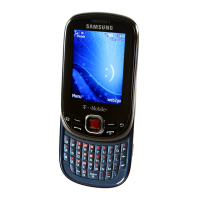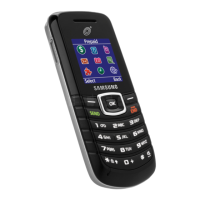Do you have a question about the Samsung SGH-T599 and is the answer not in the manual?
Step-by-step instructions for installing and removing the SIM card.
Information on installing, removing, and charging the device battery.
Instructions for inserting a microSD card to expand device storage.
Guidance on charging the device's Li-ion battery, including charging time.
Tips and features to help conserve battery power and extend usage time.
Steps for setting up the device for the first time, including language and accounts.
How to lock and unlock the device screen for security.
Information on setting up and accessing voicemail services.
Managing running applications to improve performance and battery life.
Description of the device's main function keys: Home, Menu, and Back.
The starting point for using applications, with customizable panels.
Accessing and managing applications on the device.
How to navigate through the device's screens using touch and keys.
Activating and using various gesture features for time-saving functions.
Personalizing Home screens with widgets, shortcuts, folders, or wallpapers.
Changing the Home and Lock screen wallpapers.
Methods for using the SD card, including PC connection and activation.
Steps to mount the SD card for storing photos, music, and videos.
Procedure to safely unmount the SD card to prevent data corruption.
Resetting the phone and sound settings to factory defaults.
Instructions on how to dial numbers and store them in the Contacts list.
Instructions for making emergency calls, with or without a SIM card.
How to make an emergency call when no SIM card is inserted.
Making emergency calls quickly with a SIM card installed.
How to answer or reject an incoming call.
Setting up to 99 speed dial entries for quick dialing.
Assigning phone numbers to speed dial locations.
Using the voice recognition application for various tasks.
Using Wi-Fi for calls to improve coverage in limited cellular areas.
Configuring the device to make and receive calls over Wi-Fi.
Steps to make and receive calls using the Wi-Fi Calling feature.
Features available for use during an active phone call.
Information on making and managing multi-party or conference calls.
Setting up a network service call for multiple participants.
Steps to add participants and merge calls into a multi-party call.
Answering an incoming call while a call is in progress.
Accessing and viewing a list of placed, accepted, or missed calls.
Available text input methods: Google voice typing, Samsung keyboard, Swype.
Assigning the text input method via Settings or directly from a text field.
Using Swype's sliding finger input method for text entry.
Configuring Swype preferences like vibration, sound, and auto-spacing.
Using the built-in QWERTY keypad for text entry.
Configuring keyboard types, languages, and predictive text.
Enabling predictive text for next-letter prediction and error correction.
Using Google voice recognition to convert spoken words to text.
Setting up language, speech output, and offensive word blocking.
Managing accounts to synchronize contacts and other data.
Understanding the Contacts list and how entries are stored and sorted.
Saving phone numbers and contact information into the device's memory.
Searching for contacts by name or swiping through the list.
Modifying existing contact details.
Merging multiple accounts for a single contact into one record.
Copying contact information to the SIM card or microSD card.
Adding and managing contacts from online or remote accounts.
Synchronizing data from applications like Facebook and Google.
Adding new or existing contacts to call groups.
Overview of message types: Text, Multimedia, Email, Google+, Talk, Messenger.
Steps to manually enter recipients and compose messages.
Options available before composing a message, like Search and Delete threads.
Deleting single or multiple message threads and bubbles.
Searching through messages using keywords.
Configuring settings for text, multimedia, voice, and push messages.
Configuring emergency alert settings for various alert types.
Configuring spam settings like registering numbers or phrases as spam.
Marking messages or numbers as spam.
Setting up new email accounts like Gmail, Yahoo, or Exchange.
Writing and sending new email messages.
Adjusting account settings like name, signature, and sync options.
Writing and sending emails using an Exchange account.
Setting up account name, signature, and sync preferences.
Accessing and managing Gmail accounts.
Using Google Talk for instant messaging and chat logs.
Setting the default storage for pictures and videos (Phone or Memory card).
Taking pictures using the device's built-in camera.
Simple steps to choose a subject, point the camera, and press the key.
Available shortcuts for camera functions like Focus area and Self-portrait.
Accessing stored camera images and performing basic editing tasks.
Playing video files stored on the SD card.
Accessing, renting, or purchasing movie and TV content.
Consulting calendar, creating events, and setting reminders.
Using the camera for photos and video recording.
Using the Google Chrome Web browser.
Managing phone numbers and contact information.
Reviewing and creating emails, receiving text message alerts.
Accessing and managing Gmail accounts automatically.
Messaging and sharing with friends via Google+.
Using the browser to surf the Web.
Device-specific security features like antivirus and lost phone locator.
Tracking location, viewing traffic, and getting directions.
Sending and receiving SMS and MMS messages.
Turning your device into a Wi-Fi HotSpot for internet connectivity.
Personal music manager for accessing, buying, and downloading music tracks.
Playing music files and creating playlists.
Using the GPS navigation system with voice guidance.
Making or answering calls, accessing the Contacts list.
Connecting to Play Store to download and watch movies.
Browsing, shopping, and playing songs from the Play Store.
Accessing downloadable applications and games.
Steps to download and install applications from the Play Store.
Using the voice recognition system for tasks like voice dial.
Voice-guided navigation using Scout™ by Telenav.
Accessing sound, phone, display, and security settings.
Playing video files stored on the microSD card.
Using Google Now for voice-to-text internet searching.
Uploading and sharing videos, viewing them in MPEG-4 format.
Using the Google browser to navigate the mobile web.
Bookmarking websites for quick access and managing history.
Configuring browser settings for home page, auto-fill, and privacy.
Connecting the device to a PC using USB modes like MTP and PTP.
Enabling Wi-Fi hotspot functionality to share internet.
Understanding Wi-Fi, WLAN, and Wireless Access Points.
Turning on the Wi-Fi feature to discover and connect to networks.
Activating, viewing, and assigning Bluetooth device names.
Monitoring and managing device data usage capabilities.
Turning mobile data usage on or off.
Setting warning and maximum data limits and time frames.
Sharing device data connection via USB or wirelessly.
Configuring device to make/receive calls over Wi-Fi.
Selecting preferences for Wi-Fi or Cellular network use.
Configuring general call settings like rejection and ringtones.
Managing call rejection, ringtones, and answering/ending calls.
Information on RF energy exposure from wireless phones.
Information on FCC RF exposure limits and SAR testing.
Guidelines for responsible driving and avoiding distractions.
Emphasis on safe driving and avoiding secondary tasks.
Suggestions for proper handling and care of the mobile device.
Recommendations for preventing hearing loss from loud sounds.
Maintaining separation between device and medical implants.
Requirements for digital wireless devices to be compatible with hearing aids.
Details on what is covered by the warranty and for how long.
Specifies warranty periods for handsets, batteries, and accessories.
Lists conditions and damages not covered by the limited warranty.
Legal agreement for the use of preloaded software.
Step-by-step instructions for installing and removing the SIM card.
Information on installing, removing, and charging the device battery.
Instructions for inserting a microSD card to expand device storage.
Guidance on charging the device's Li-ion battery, including charging time.
Tips and features to help conserve battery power and extend usage time.
Steps for setting up the device for the first time, including language and accounts.
How to lock and unlock the device screen for security.
Information on setting up and accessing voicemail services.
Managing running applications to improve performance and battery life.
Description of the device's main function keys: Home, Menu, and Back.
The starting point for using applications, with customizable panels.
Accessing and managing applications on the device.
How to navigate through the device's screens using touch and keys.
Activating and using various gesture features for time-saving functions.
Personalizing Home screens with widgets, shortcuts, folders, or wallpapers.
Changing the Home and Lock screen wallpapers.
Methods for using the SD card, including PC connection and activation.
Steps to mount the SD card for storing photos, music, and videos.
Procedure to safely unmount the SD card to prevent data corruption.
Resetting the phone and sound settings to factory defaults.
Instructions on how to dial numbers and store them in the Contacts list.
Instructions for making emergency calls, with or without a SIM card.
How to make an emergency call when no SIM card is inserted.
Making emergency calls quickly with a SIM card installed.
How to answer or reject an incoming call.
Setting up to 99 speed dial entries for quick dialing.
Assigning phone numbers to speed dial locations.
Using the voice recognition application for various tasks.
Using Wi-Fi for calls to improve coverage in limited cellular areas.
Configuring the device to make and receive calls over Wi-Fi.
Steps to make and receive calls using the Wi-Fi Calling feature.
Features available for use during an active phone call.
Information on making and managing multi-party or conference calls.
Setting up a network service call for multiple participants.
Steps to add participants and merge calls into a multi-party call.
Answering an incoming call while a call is in progress.
Accessing and viewing a list of placed, accepted, or missed calls.
Available text input methods: Google voice typing, Samsung keyboard, Swype.
Assigning the text input method via Settings or directly from a text field.
Using Swype's sliding finger input method for text entry.
Configuring Swype preferences like vibration, sound, and auto-spacing.
Using the built-in QWERTY keypad for text entry.
Configuring keyboard types, languages, and predictive text.
Enabling predictive text for next-letter prediction and error correction.
Using Google voice recognition to convert spoken words to text.
Setting up language, speech output, and offensive word blocking.
Managing accounts to synchronize contacts and other data.
Understanding the Contacts list and how entries are stored and sorted.
Saving phone numbers and contact information into the device's memory.
Searching for contacts by name or swiping through the list.
Modifying existing contact details.
Merging multiple accounts for a single contact into one record.
Copying contact information to the SIM card or microSD card.
Adding and managing contacts from online or remote accounts.
Synchronizing data from applications like Facebook and Google.
Adding new or existing contacts to call groups.
Overview of message types: Text, Multimedia, Email, Google+, Talk, Messenger.
Steps to manually enter recipients and compose messages.
Options available before composing a message, like Search and Delete threads.
Deleting single or multiple message threads and bubbles.
Searching through messages using keywords.
Configuring settings for text, multimedia, voice, and push messages.
Configuring emergency alert settings for various alert types.
Configuring spam settings like registering numbers or phrases as spam.
Marking messages or numbers as spam.
Setting up new email accounts like Gmail, Yahoo, or Exchange.
Writing and sending new email messages.
Adjusting account settings like name, signature, and sync options.
Writing and sending emails using an Exchange account.
Setting up account name, signature, and sync preferences.
Accessing and managing Gmail accounts.
Using Google Talk for instant messaging and chat logs.
Setting the default storage for pictures and videos (Phone or Memory card).
Taking pictures using the device's built-in camera.
Simple steps to choose a subject, point the camera, and press the key.
Available shortcuts for camera functions like Focus area and Self-portrait.
Accessing stored camera images and performing basic editing tasks.
Playing video files stored on the SD card.
Accessing, renting, or purchasing movie and TV content.
Consulting calendar, creating events, and setting reminders.
Using the camera for photos and video recording.
Using the Google Chrome Web browser.
Managing phone numbers and contact information.
Reviewing and creating emails, receiving text message alerts.
Accessing and managing Gmail accounts automatically.
Messaging and sharing with friends via Google+.
Using the browser to surf the Web.
Device-specific security features like antivirus and lost phone locator.
Tracking location, viewing traffic, and getting directions.
Sending and receiving SMS and MMS messages.
Turning your device into a Wi-Fi HotSpot for internet connectivity.
Personal music manager for accessing, buying, and downloading music tracks.
Playing music files and creating playlists.
Using the GPS navigation system with voice guidance.
Making or answering calls, accessing the Contacts list.
Connecting to Play Store to download and watch movies.
Browsing, shopping, and playing songs from the Play Store.
Accessing downloadable applications and games.
Steps to download and install applications from the Play Store.
Using the voice recognition system for tasks like voice dial.
Voice-guided navigation using Scout™ by Telenav.
Accessing sound, phone, display, and security settings.
Playing video files stored on the microSD card.
Using Google Now for voice-to-text internet searching.
Uploading and sharing videos, viewing them in MPEG-4 format.
Using the Google browser to navigate the mobile web.
Bookmarking websites for quick access and managing history.
Configuring browser settings for home page, auto-fill, and privacy.
Connecting the device to a PC using USB modes like MTP and PTP.
Enabling Wi-Fi hotspot functionality to share internet.
Understanding Wi-Fi, WLAN, and Wireless Access Points.
Turning on the Wi-Fi feature to discover and connect to networks.
Activating, viewing, and assigning Bluetooth device names.
Monitoring and managing device data usage capabilities.
Turning mobile data usage on or off.
Setting warning and maximum data limits and time frames.
Sharing device data connection via USB or wirelessly.
Configuring device to make/receive calls over Wi-Fi.
Selecting preferences for Wi-Fi or Cellular network use.
Configuring general call settings like rejection and ringtones.
Managing call rejection, ringtones, and answering/ending calls.
Information on RF energy exposure from wireless phones.
Information on FCC RF exposure limits and SAR testing.
Guidelines for responsible driving and avoiding distractions.
Emphasis on safe driving and avoiding secondary tasks.
Suggestions for proper handling and care of the mobile device.
Recommendations for preventing hearing loss from loud sounds.
Maintaining separation between device and medical implants.
Requirements for digital wireless devices to be compatible with hearing aids.
Details on what is covered by the warranty and for how long.
Specifies warranty periods for handsets, batteries, and accessories.
Lists conditions and damages not covered by the limited warranty.
Legal agreement for the use of preloaded software.
| Model | SGH-T599 |
|---|---|
| Network Technology | GSM / HSPA |
| 2G bands | GSM 850 / 900 / 1800 / 1900 |
| Speed | HSPA 21.1/5.76 Mbps |
| GPRS | Yes |
| EDGE | Yes |
| SIM | Mini-SIM |
| Type | TFT capacitive touchscreen |
| Size | 4.0 inches |
| Multitouch | Yes |
| CPU | Dual-core 1.2 GHz Krait |
| GPU | Adreno 305 |
| Card slot | microSD, up to 64 GB |
| Internal | 4 GB |
| RAM | 1 GB |
| Video | 720p@30fps |
| Secondary Camera | VGA |
| Alert types | Vibration; MP3, WAV ringtones |
| Loudspeaker | Yes |
| 3.5mm jack | Yes |
| WLAN | Wi-Fi 802.11 b/g/n, Wi-Fi Direct, hotspot |
| Bluetooth | 4.0, A2DP |
| GPS | Yes, with A-GPS |
| Radio | FM radio |
| USB | microUSB 2.0 |
| Sensors | Accelerometer, proximity |
| Messaging | SMS (threaded view), MMS, Email, Push Email, IM |
| Browser | HTML5 |
| Java | No |
| Stand-by | Up to 300 h |
| Colors | Black, White |
| Announced | 2013 |
| Status | Available |
| Resolution | 480 x 800 pixels |
| OS | Android 4.1 (Jelly Bean) |
| Features | Geo-tagging |
| Talk time | Up to 7 h |



